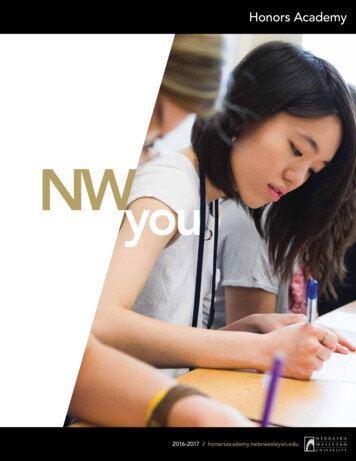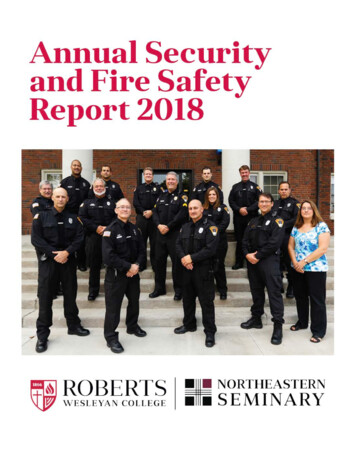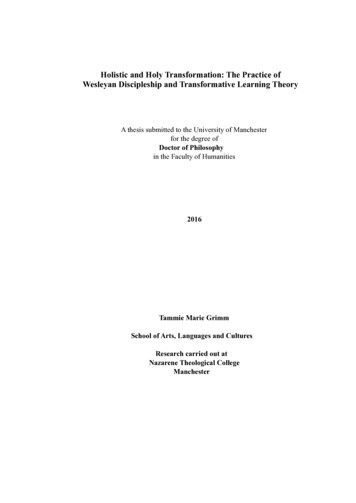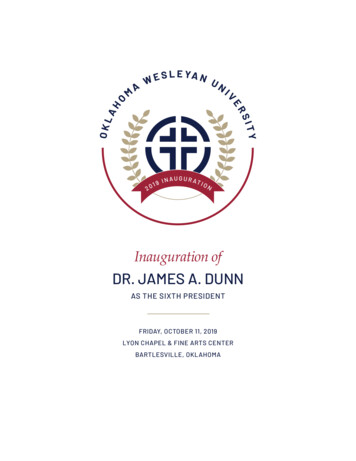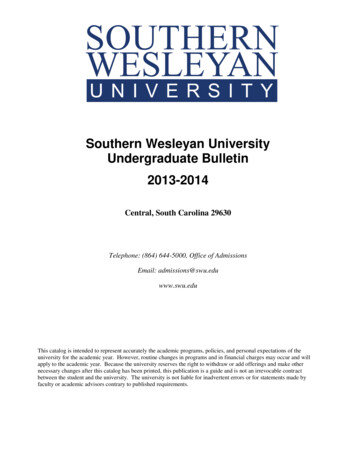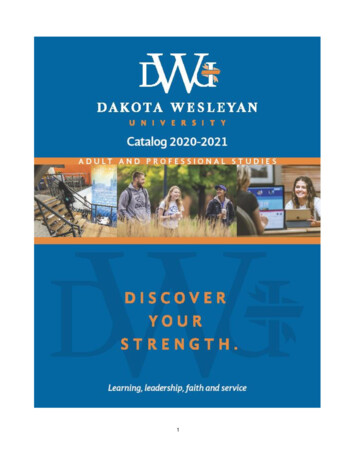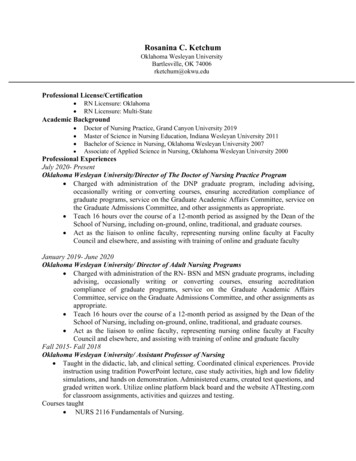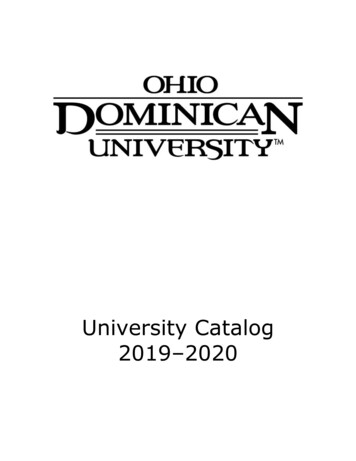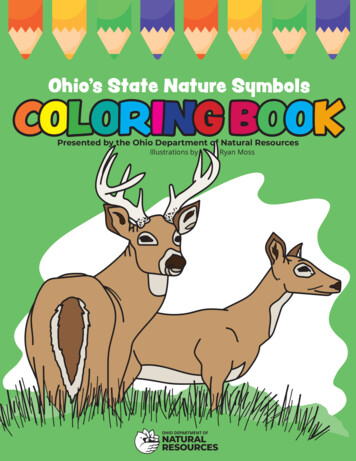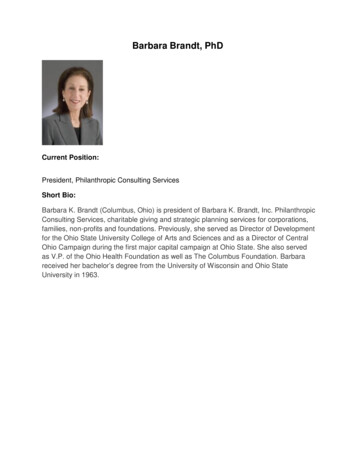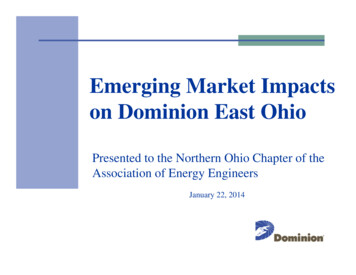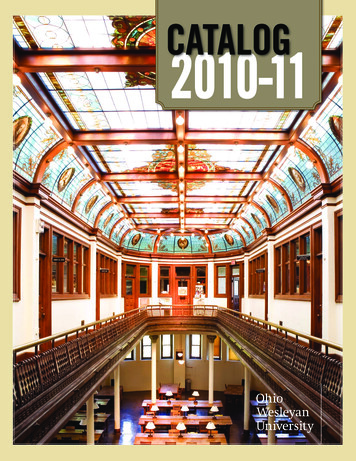
Transcription
Catalog2010-11
Correspondence DirectoryCorrespondence should be addressed to: Ohio Wesleyan University, 61 South Sandusky Street, Delaware, Ohio 43015. The University’s general telephonenumber is (740) 368-2000 and the University’s Web site is located at www.owu.edu. When dialing from off campus, use “368” (preceded with area code“740,” if required) and the extension for the offices and individuals listed below. A complete directory of University offices and employees is available onlineat http://directories.owu.edu/.ACADEMIC CONCERNSDr. Charles Stinemetz, Dean of Academic Affairs (Extension 3112, clstinem@owu.edu)Dr. Martin Hipsky, Associate Dean of First Year Students, (Extension 3105, mahipsky@owu.edu)ADMISSION, FINANCIAL AIDAND COMMUNICATIONSDr. William Preble, Vice President for University Enrollment and Strategic Communication (Extension 3025,wdpreble@owu.edu)ATHLETICSMr. Roger Ingles, Director of Athletics (Extension 3738, rdingles@owu.edu)CAREER SERVICESMs. Leslie Delerme, Director of Career Services (Extension 3152, ljdelerm@owu.edu)CHAPLAINThe Rev. Jon Powers (Extension 3082, jrpowers@owu.edu)COUNSELINGDr. Colleen Cook (Extension 3145, cmcook@owu.edu)DEPOSITS, FEES & CHARGESMs. Pam Venters, Student Accounts (Extension 3362, owstuact@owu.edu)GIFTSMr. Charles Powell, Vice President for University Relations(Extension 3300)HONORS PROGRAMDr. Edward Burtt, Co-Coordinator (Extension 3886, honors@owu.edu)Dr. Amy McClure, Co-Coordinator (Extension 3562, honors@owu.edu)HOUSINGMs. Wendy Piper, Assistant Dean for Student Affairs/Director of Residential Life(Extension 3177, wlpiper@owu.edu)INTERNATIONALSTUDENT SERVICESMr. Darrell Albon, Director of International Student Services(Extension 3070, owuintl@owu.edu)MARKETING & COMMUNICATIONMr. Mark Cooper, Director (Extension 3108, mecooper@owu.edu)MULTICULTURAL STUDENT AFFAIRS Ms. Terree Stevenson, Director (Extension 3070, tlsteven@owu.edu)REGISTRATION, READMISSION& TRANSCRIPTSMs. Shelly McMahon, Registrar (Extension 3200, registrar@owu.edu)STUDENT LIFEDr. Craig Ullom, Vice President for Student Affairs (Extension 3131, ceullom@owu.edu)SUMMER PROGRAMSDr. Charles Stinemetz, Dean of Academic Affairs (Extension 3112, clstinem@owu.edu)WELLNESS CENTERMs. Marsha Tilden, Director (Extension 3163, matilden@owu.edu)Ohio Wesleyan admits all qualified students and administers financial assistance without regard to sex, race, religion, color, national origin, or handicap.
2010/2011 CatalogOhio Wesleyan UniversityContentsContentsCalendar.inside back coverThe University. 1Introduction. 1Statement of Aims. 3Intellectual Freedom and Responsibility. 4Statement on Student Rights. 5University Diversity Efforts. 5Traditions. 6Academic Regulations and ProceduresAcademic Advising. 9Admission. 9Advanced Placement. 9International Baccalaureate. 11Examinations for Placement and/or Credit. 12Registration in Courses. 12Reports and Grades. 14Residence Requirement. 16Academic Probation and Dismissal. 17Academic Honesty. 17Academic Grievance Policy. 21Responsibility for Meeting Requirements. 22Final Examination Policy. 23Leave of Absence. 23Withdrawal from the University. 23Reinstatement. 24Classification of Students . 24Transfer of Credits. 24Student-Initiated Courses . 25Petitions. 25Academic Honors and PrizesAcademic Honors. 27Prizes and Awards. 29Honorary Societies. 36Degrees and Special ProgramsRequirements for All Degrees. 37The Bachelor of Arts Degree. 39Professional Degrees. 42Two Bachelor’s Degrees. 43Combined Bachelor’s/Professional Degrees. 43Other Pre-Professional Programs. 44Other Interdepartmental Majors. 44Self-Designed Majors. 44The Sagan National Colloquium. 45i
2010/2011 CatalogOhio Wesleyan UniversityContentsCross-Cultural Experience. 45Off-Campus Study Programs. 45International Programs. 46Domestic Programs. 49Apprenticeships and Internships. 50Special Language Program. 51Summer School. 51Majors and Courses of InstructionKey to Abbreviations. 53Course Selection. 53Majors and Course Descriptions. 54Student Life and Non-Academic RegulationsStudent Life. 277The Student Handbook. 277Expenses and Financial AidTuition and Fees. 279Financial Aid. 279Payment Methods. 284Withdrawals and Refunds. 285FacilitiesLibraries & Information Services. 287University Housing. 288Instructional and Administrative Buildings. 289University Offices. 293Student Offices. 293The Corporation (Board of Trustees). 294Adjunct Faculty. 302GLCA New York Arts Program. 302Faculty and Staff Emeriti. 302Department Chairpersons 2010-2011. 305Faculty of Instruction. 306Index. 315ii
The UniversityIntroductionIntroductionOhio Wesleyan University is an independent, undergraduate liberal arts institution enrolling about1,850 students, almost equally men and women, from 47 states and 57 countries. The multicultural enrollment total of 18.5 percent includes U.S. multicultural students (9 percent) andinternational students (9.5 percent), and the University is strongly committed to racial, ethnic, andcultural diversity. The 2008 freshman class presented an average SAT score range of 1710-1960, and32 percent of the students ranked in the top 10 percent of their high school class.Outstanding teaching is a hallmark of the University, which is best-known for the quality andaccessibility of its faculty. Ohio Wesleyan has 137 full-time faculty positions, of which 36 percentare female. One hundred percent of full-time tenure-track faculty hold the Ph.D. or highest degreeattainable in their field.The University confers the Bachelor of Arts, Bachelor of Fine Arts, and Bachelor of Music; andoffers combined-degree (3-2) programs in engineering, interdisciplinary and applied science,medical technology, optometry and physical therapy. Degrees are offered through 24 academicdepartments and several interdisciplinary programs. Distinctive features of the academic programinclude the Arneson Institute for Practical Politics and Public Affairs; the Woltemade Center forEconomics, Business and Entrepreneurship; the Sagan National Colloquium and its associatedSagan Fellows classes; a four-year Honors Program; and extensive opportunities for independentresearch, internships and off-campus study.Ohio Wesleyan is accredited by The Higher Learning Commission and is a member of the NorthCentral Association of Colleges and Schools located at 30 North LaSalle Street, Suite 2400,Chicago, Ill. 60602-2504 (Phone: 312-263-0456, www.ncahigherlearningcommission.org). Thecollege is also approved by the American Association of University Women and is a member ofthe Association of American Colleges and the University Senate of the United Methodist Church.Appropriate departments are approved or accredited by the American Chemical Society Committeeon Professional Training, the National Association of Schools of Music, the Ohio Department ofEducation (for licensure of elementary and secondary school teachers), and the National Councilfor Accreditation of Teacher Education (NCATE). The University is a member of the Great LakesColleges Association, Inc., a non-profit corporation of 13 leading independent institutions inIndiana, Michigan and Ohio.Founded by Methodists in 1842, Ohio Wesleyan maintains an active affiliation with The UnitedMethodist Church, but welcomes students of all religious faiths. The University Chaplain providessupport for all denominations and coordinates an active program of social action and communityservice. Known early in its history as the “West Point of Missions” because of the number ofgraduates who served abroad as missionaries, Ohio Wesleyan later was recognized for the numberof alumni who served as Peace Corps volunteers. Today, that same commitment to serving societymanifests itself in the activities of our students, an extraordinary percentage of whom participate involunteerism and philanthropic initiatives. In 2010, Ohio Wesleyan was one of only three collegesnationwide to receive the President’s Award for Excellence in General Community Service.For more than 160 years, the quality of an Ohio Wesleyan education has been reflected in theUniversity’s alumni. Charles Warren Fairbanks, class of 1872, served as vice president of the UnitedStates under Teddy Roosevelt. Branch Rickey, ’20, was named ESPN’s most influential sportsfigure of the 20th century, for breaking the color barrier in professional baseball by bringing JackieRobinson to the Brooklyn Dodgers. Clergyman Norman Vincent Peale ’20, inspired millions withhis book The Power of Positive Thinking. Ohio Wesleyan boasts two Nobel Prize winners: Sherwood1
The UniversityIntroductionRowland ’48, won the prize in chemistry in 1995, and as a member of the Intergovernmental Panelon Climate Change, Woodrow Clark ’67 shared the Nobel Peace Prize with Al Gore.Other notable alumni include: Robert E. Lee ’39, Pulitzer Prize-winning playwright of Inherit the Wind Jean Carper ’53, best-selling author and columnist Melvin Van Peebles,’53, multiple Tony-nominated writer, actor, and filmmaker David H. Smith ’53, inventor of the HiB vaccine Phillip Meek ’59, retired Senior VP and President, publishing group, Capital Cities/ABC George Conrades ’61, Executive Chairman, Akamai Technologies Paul Schimmel, Ph.D., ’62, Ernst & Jean Hahn Professor of Molecular Biology, SchimmelYang Laboratory, Scripps Research Institute Edward D. Miller, M.D., ’64, CEO and Dean of the Medical Faculty, Johns HopkinsSchool of Medicine Richard North Patterson ’68, multiple best-selling author Jo Ann Emerson, ’72, Member of Congress, Missouri’s Eighth District Greg Moore ’76, Editor, The Denver Post Tom Jolly, ’77, Sports Editor, The New York Times Bob DiBiasio, ’77, Vice President for Public Relations, the Cleveland Indians Byron Pitts ’82, CBS National and 60 Minutes Correspondent Jeff Long ’82, Director, Men’s Athletics, University of Arkansas Dean Hood ’86, Head Football Coach, Eastern Kentucky University Abram Wilson ’95, internationally known jazz musician and composer Keith Dailey, ’02, Communications Director, Office of Ohio Governor Ted StricklandAnd many more leaders in medicine, business, education, athletics, industry, government, law, arts,and nonprofit organizations.Significant increases in the size and academic quality of the student body have contributed to asteadily rising academic reputation; an aggressive strategy for recruiting and educating honorsstudents has provided an academic atmosphere unparalleled in the institution’s distinguishedhistory. A collegial and participatory strategic planning has united the campus around an ambitiousset of long- and short-term goals, many of which are related to improvements to the University’sbuilt environment. In 2010, the new Meek Aquatic and Recreation Center and three fullyrenovated residences for senior men and women will open. Selby Field also will undergo additionalimprovements.2
The UniversityIntroductionStatement of AimsInitiatives in volunteerism and public service have strengthened the historic link between the liberaland civic arts. Ohio Wesleyan was one of 39 colleges and universities to receive a 2 million grantfrom the Lilly Endowments for the “theological exploration of vocation.” The University also hasreceived a variety of grants from such organizations as the National Science Foundation, NationalInstitutes of Health, National Endowment for the Humanities, National Endowment for the Arts,John Simon Guggenheim Memorial Foundation, and the Fulbright Program.OWU continues to be recognized by U.S. News and World Report as being among the nation’stop liberal arts colleges. Ohio Wesleyan also holds its place in The Templeton Guide: Collegesthat Encourage Character Development and in its guidebook. Ohio Wesleyan currently is listedin The Princeton Review Guide to the Best 368 Colleges, The Fiske Guide to Colleges 2010, and theWashington Monthly college guide. The University also is included in the latest edition of CollegesThat Change Lives by Loren Pope, former education editor for The New York Times. In 2010 TheDaily Beast, one of the nation’s most-read web sites listed OWU as one of the country’s 15 HottestColleges.Statement of AimsSince its founding, Ohio Wesleyan has maintained its connection with the Methodist (now UnitedMethodist) Church, offering a quality of scholarship, leadership, and service that has enrichedboth Church and society. Its charter provided that “the University is forever to be conducted onthe most liberal principles, accessible to all religious denominations, and designed for the benefitof our citizens in general.” In the spirit of this heritage, the University defines itself as a communityof teachers and students devoted to the free pursuit of truth. It attempts to develop in its studentsqualities of intellect and character that will be useful no matter what they choose to do in later life.The transmission, extension, and discovery of knowledge are central to the liberal arts tradition.While encouraging professional scholarship and feeling justifiably proud of its faculty and graduateswho enjoy national or international reputations in their fields, the University has as its preeminentpurpose to be a quality institution for teaching and learning. Because effective teaching is of thehighest importance, members of the faculty regularly are reviewed and evaluated for excellence inteaching.Ohio Wesleyan judges itself successful when it has accomplished three objectives in its work withstudents:The first is to impart knowledge. Included here is knowledge about our cultural past; a liberaleducation communicates what great minds have thought, great artists have created, great leadershave done. Also included is new knowledge; a liberal education communicates what is beingacquired on the frontiers of contemporary inquiry and current advances of the human spirit. Theobjective of imparting knowledge begins with the conviction that it is intrinsically worthwhile topossess the knowledge and insight transmitted through the humanities, arts, and sciences.A second major objective is to develop and enhance certain important capabilities of students.As they progress through the curriculum of the University, students secure the foundation skillsof reading, writing, and quantitative analysis. They build on these skills the capacity to thinkcritically and logically, to employ the methods of the different fields of inquiry, and to understandthe symbolic languages used to codify and communicate knowledge in today’s society. They may3
The UniversityStatement of AimsIntellectual Freedom and Responsibilitydevelop aesthetic sensibilities or creative talents in several fields. Many students learn to integratetheory with practice by preparing for careers within various disciplines and through pre-professionaland professional programs.The third objective is to place education in the context of values. Liberal education seeks todevelop in students understanding of themselves, appreciation of others, and willingness to meetthe responsibilities of citizenship in a free society. It recognizes that trained sensitivity to privateand public value issues, grounded in a sound grasp of various cultural heritages, is important formaturation and for living a good life. It accords high honor to intellectual honesty. Consistent withour Methodist tradition, Ohio Wesleyan encourages concern for all religious and ethical issues andstimulates its students to examine their own views in light of these issues.To the extent that Ohio Wesleyan educates liberally, it fulfills its ultimate purpose of equippingstudents with knowledge, competence, and character for leadership, service, and continued learningin a complex and increasingly global society.IntellectualFreedom andResponsibilityA Joint Statement by the Trustees and Faculty Members of Ohio Wesleyan UniversityThe Charter of Ohio Wesleyan University, granted in 1842, provides that “the University isforever to be conducted on the most liberal principles, accessible to all religious denominations,and designed for the benefit of our citizens in general.” The spirit of this statement has persistedthrough the years, so that today Ohio Wesleyan continues to live and thrive in an environment ofintellectual freedom. It is, therefore, fully committed to a more recent declaration of the GeneralConference of the Methodist Church (1952):“Our role is not to suppress ideas, but to open channels of communication,so that (men and women) can come to know the thoughts of their neighbors,and so that the best thoughts of all (men and women) can come to be thepossessions of all humanity.”In pursuit of this tradition, the administration has maintained for students and faculty alike aclimate of freedom in learning and inquiry. As a specific guarantee of this climate of intellectualfreedom, the faculty and the Board of Trustees have adopted the 1940 statement of the AmericanAssociation of University Professors relative to academic freedom. It states: “The teacher is entitledto freedom in the classroom in discussing (his/her) subject, but should be careful not to introduce. . . controversial matter which has no relation to (the) subject.” The only limitation that canappropriately be placed upon the teacher’s academic activities are those required by the acceptedstandards of (his/her) professions, such as sustained inquiry, propriety of statement, integrity ofcharacter, and objectivity of exposition.Ohio Wesleyan has recognized that its faculty and students are citizens of local, state, and nationalcommunities, as well as members of an academic community. The 1940 statement of the AmericanAssociation of University Professors emphasizes the freedom and responsibility of teachers as citizensin the following words: “When (the teacher) speaks or writes as a citizen (he/she) should be freefrom institutional censorship or discipline, but (his/her) special position in the community imposesspecial obligations. As a (person) of learning and an educational officer (he/she) should remember4
The UniversityIntellectual Freedom and ResponsibilityStatement on Student RightsUniversity Diversity Effortsthat the public may judge (his/her) profession and institution by (his/her) utterances. Hence (he/she) should at all times be accurate, should exercise appropriate restraint, should show respect forthe opinions of others, and should make every effort to indicate that (he/she) is not an institutional(spokesperson).” Within these appropriate limits faculty members should be free to think and act ascitizens of the whole community.Equivalent importance is placed upon academic freedom and responsibility for students at OhioWesleyan, as expressed by the faculty and Board of Trustees in their adoption of the following 1965statement by the American Association of University Professors:“Free inquiry and free expression are essential attributes of the community of scholars. As membersof the community, students should be encouraged to develop the capacity for critical judgmentand to engage in a sustained and independent search for truth. The freedom to learn dependsupon appropriate opportunities and conditions in the classroom, on the campus, and in the largercommunity. The responsibility to secure and to respect general conditions conducive to the freedomto learn is shared by all members of the academic community. Students should endeavor to exercisetheir freedom with maturity and responsibility.”Statement onStudent RightsUniversity DiversityEffortsA Summaryof the PlanIn 1970, the Ohio Wesleyan faculty adopted the Joint Statement on Rights and Freedoms ofStudents, which endorses a concept of community responsibility where students, along with facultyand administrators, are encouraged to play a more determining role in formulation of institutionalpolicy.An essential function of a university is to help all persons realize their potential. To this end, OhioWesleyan University affirms its support of equal opportunity for and nondiscrimination against allqualified persons regardless of race, color, creed, national origin, sex, disability, sexual orientation,age, religion, or family relationship. Furthermore, Ohio Wesleyan University asserts that diversitywill be pursued to provide access to employment, benefits, programs, education, and facilities toqualified individuals.Ohio Wesleyan University believes that minimum or least-effort actions and procedures areineffective in assuring equal employment and diversity. Simple abstention from overt discriminationor the rewriting of the job descriptions and criteria for employment will not fulfill moralobligations. Culturally biased preferences for one sex over another or one race over another are notvalid reasons for exclusionary practices or unjust criteria for employment.Since the elimination of any discriminatory practices, intentional or unintentional, is a moralconcern, Ohio Wesleyan University affirms that its policies and practices are designed to ensurewomen and minorities equal opportunity for education, employment, and advancement inresponsibilities and in remuneration. Ohio Wesleyan fully accepts its responsibilities and pledges5
The UniversityUniversity Diversity EffortsTraditionsto provide equal opportunity in all of its relationships with employees and in all facets of itsoperations.The University requires the full cooperation of every University employee in order to meet its moralobligations. Vigorous efforts to attain the goals set forth in this document are the responsibilityof all persons and departments in the University. All publications and news releases issued by theUniversity shall be prepared with diversity in mind.The plan for implementing the diversity policy is available at several locations on the OhioWesleyan campus, including the Human Resource Department, Provost’s, and Dean of Studentsoffices.TraditionsOhio Wesleyan has been acquiring traditions since 1844, when the College of Liberal Arts openedits doors with an enrollment of 29 male students taught by three professors. The college was housedin Elliott Hall, formerly the Mansion House Hotel, which had been constructed in the early1830s when the current East Campus was a popular health resort. The resort was known for the“health-giving although odoriferous waters” of its famed Sulphur Spring, a favorite spot of futuregenerations of students. It was at the spring that Rutherford B. Hayes, Delaware native and 19thpresident of the United States, wooed and won Lucy Webb, one of Ohio Wesleyan’s first femalestudent and the person for whom Hayes Hall is named.In 1853, the Ohio Wesleyan Female College, an independent institution, was established inDelaware and four years later moved into the new Monnett Hall. In 1877, the Female College andUniversity merged, and during the 1977-78 academic year Ohio Wesleyan celebrated 100 years ofcoeducation.For many years, Monnett Hall was the center of women’s life on campus. Monnett Weekend,later called Monnett/Kids and Sibs Weekend, took its name from the Hall and the activitiesthat occurred there. Scheduled to coincide with the nationwide celebration of Mother’s Day inMay, the Weekend was strictly a women’s affair for many years. All events were scheduled on theMonnett Campus, and men were banned from the area while women students danced around theMaypole. During those years, men apparently developed their own tradition by arriving on theMonnett Campus early in the morning and concealing themselves in trees from which to watchthe festivities. In later years, the Weekend became a time for both men and women students toentertain their parents and share their campus experiences with them.During Homecoming/Family Weekend, students, parents, and alumni are on the campus fortailgating, athletics
for Accreditation of Teacher Education (NCATE). The University is a member of the Great Lakes Colleges Association, Inc., a non-profit corporation of 13 leading independent institutions in Indiana, Michigan and Ohio. Founded by Methodists in 1842, Ohio Wesleyan maintains an active affiliation with The United
